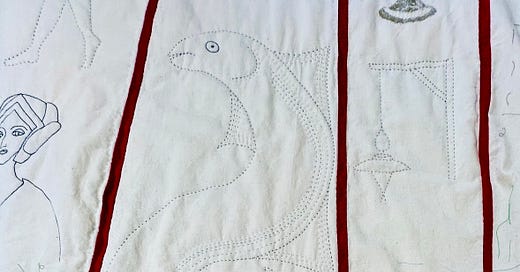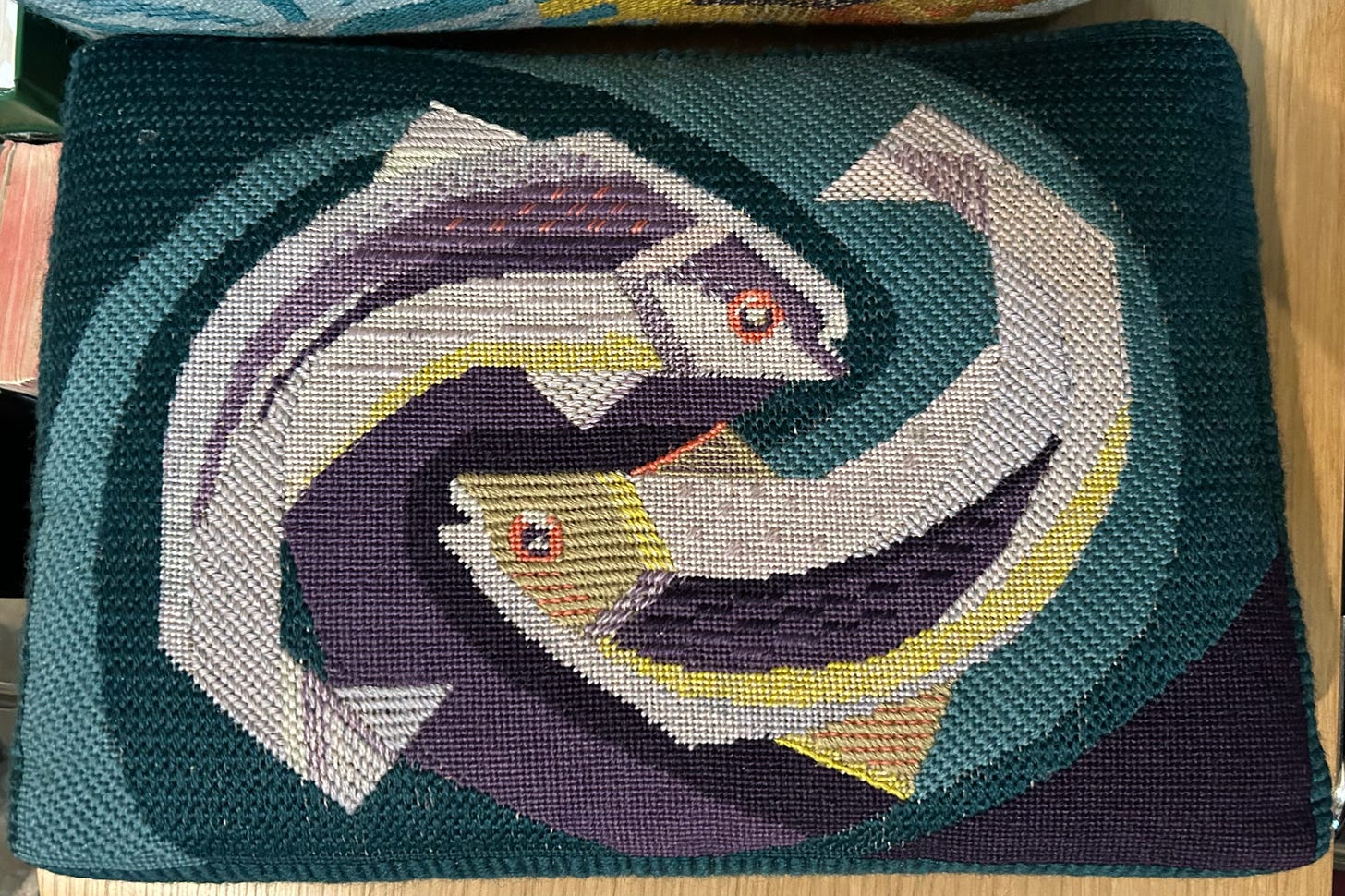In a recent post, I wrote an introduction to my Cromwell Cloke, with a view to sharing the “becoming” of a piece of my textile art. With that in mind, this series discusses some of the objects depicted on the Cloke, and the creative decisions behind each piece. It also gives me an opportunity to record sources and references both in and outside the text of Hilary Mantel’s Cromwell Trilogy. To date, these posts have focused on the Cardinal Section, but I now need to get to the archives to look at a couple of items before adding to that part of the Cloke. So let’s turn our attention to prophecies…
Content warning: brief reference to suicide, drowning
Last week The Guardian reported that a ten feet long oarfish, harbinger of doom, had been washed up on the coast of California - the second such incident this year. Oarfish live in the deep ocean and have no business being washed up, so the body of this poor fish is of considerable interest to oceanographers. And perhaps it is also of interest to those who can predict the future: oarfish, traditionally considered signs of impending disaster, are also known as “doomsday fish”. I was interested - and to be honest, unsettled - to note the number of press reports that referenced doom and disaster in their headlines at the discovery of this fish of prodigal size.
Readers of Hilary Mantel’s Cromwell Trilogy have another reason to note the beaching of a large doomsday fish. It seems to echo an episode in Wolf Hall. In the Spring of 1532:
Late in May, two fish of prodigal size are caught in the Thames, or rather they are washed up, dying, on the muddy shore. ‘Am I expected to do something about it?’ he says, when Johane brings the news in. ‘No,’ she says. ‘At least I don’t think so. It’s a portent, isn’t it? It’s an omen, that’s all.’ (Wolf Hall, ‘Alas WhatShall I Do For Love?’)
This seems such a strange and otherworldly happening that I wondered whether it originated in Hilary Mantel’s imagination - or was it based on something real? And what were these large fish? Whales? Oarfish? A type of Tudor fish no longer to be seen in English waters?
So I turned to the historical record. There was no mention that I could find in the English State Papers. So imaginary fish then. Except - in the Venice State Papers, there is a letter dated May 31 1532 from Carlo Capello that reads:
On that same day, in the Thames, two fishes were caught, each measuring 30 feet in length, 10 feet high, and 11 feet broad, the one was a male, the other a female, which was with young, and had two cubs in its belly. The one was taken at Greenwich, the other at the Tower of London. The people here in general consider this a prodigy foreboding future evil, which they likewise anticipate from the fact, that within the last few days, fourteen individuals, including men and women, have committed suicide by hanging, or drowning themselves in the Thames. 1
Prodigal or Prodigious?
I note that my reference notebook for the Cromwell Cloke lists this item as “The fish of prodigious size”. When I started to draft this note, the title referred once again to prodigious size. The only thing of prodigious size in the Trilogy is Thomas Cromwell’s memory. It seems I have been misquoting the fish reference for 15 years. After years of mis-titling, the expression prodigal size doesn’t seem right - but knowing that it is a nod to the 1532 letter makes all the difference.
Fish on the Cloke
Soon after I decided that the prodigious/prodigal fish should be included on the Cromwell Cloke, I saw two excellent fish on a needlepoint kneeler in Chichester Cathedral. I wanted my fish to look rather like these, but my needle had other ideas.
My fish got longer and thinner and became entwined. They have a somewhat eel-like demeanour. I didn’t like them at first - I’m scared of eels. But having seen the doomsday fish last week, I now think they are just right. They swim on a new section of the Cromwell Cloke devoted to prophecies. And some of the prophecies in the Cromwell Trilogy are grim. So I am combining work on this section with more pleasant items elsewhere. And hoping that my fish are not harbingers of doom.
This serves as a timely reminder to me not to rely on English State papers alone, but to remember that dispatches from diplomats, ambassadors, and others may well be found elsewhere i.e. at their destinations. I spent a frustrating couple of hours on Friday trying to check something supposedly said by Ambassador Chapuys - and of course eventually realised it would be held in the Spanish papers. And that was where I found the reference I needed. More about that another time.






Your needle clearly knew what it was doing. I too had to look up the oarfish reports.
Thank you--I saw the oar fish in the news and was surprised at how often they come to my memory.